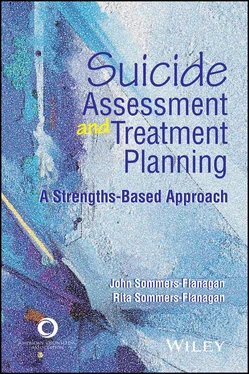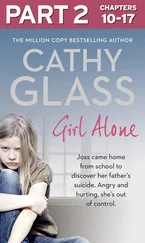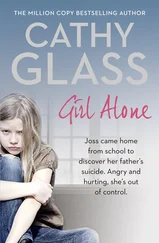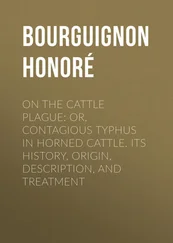John Sommers-Flanagan - Suicide Assessment and Treatment Planning
Здесь есть возможность читать онлайн «John Sommers-Flanagan - Suicide Assessment and Treatment Planning» — ознакомительный отрывок электронной книги совершенно бесплатно, а после прочтения отрывка купить полную версию. В некоторых случаях можно слушать аудио, скачать через торрент в формате fb2 и присутствует краткое содержание. Жанр: unrecognised, на английском языке. Описание произведения, (предисловие) а так же отзывы посетителей доступны на портале библиотеки ЛибКат.
- Название:Suicide Assessment and Treatment Planning
- Автор:
- Жанр:
- Год:неизвестен
- ISBN:нет данных
- Рейтинг книги:4 / 5. Голосов: 1
-
Избранное:Добавить в избранное
- Отзывы:
-
Ваша оценка:
- 80
- 1
- 2
- 3
- 4
- 5
Suicide Assessment and Treatment Planning: краткое содержание, описание и аннотация
Предлагаем к чтению аннотацию, описание, краткое содержание или предисловие (зависит от того, что написал сам автор книги «Suicide Assessment and Treatment Planning»). Если вы не нашли необходимую информацию о книге — напишите в комментариях, мы постараемся отыскать её.
Suicide Assessment and Treatment Planning — читать онлайн ознакомительный отрывок
Ниже представлен текст книги, разбитый по страницам. Система сохранения места последней прочитанной страницы, позволяет с удобством читать онлайн бесплатно книгу «Suicide Assessment and Treatment Planning», без необходимости каждый раз заново искать на чём Вы остановились. Поставьте закладку, и сможете в любой момент перейти на страницу, на которой закончили чтение.
Интервал:
Закладка:
Amanda Tashjian – University of Arizona
Benjamin Willis – University of Scranton
Beronica Salazar – Northwest Nazarene University
Cara Metz – Ashford University
Christie Nelson – University of North Carolina–Charlotte
Claudia Sadler-Gerhardt – Ashland Theological Seminary
Dari Tahani – University of Toledo
Devyn Savitsky – Ohio University
Diane Shea – Holy Family University
Erin M. Hopper – Liberty University
Jill Schott – Onward Behavioral Health
Jo-Ann Sanders – Heidelberg University
John Harrichand – State University of New York–Brockport
Julie Williams – Thrive Counseling & Consultation, Tampa, Florida
Kara Hurt-Avila – Montana State University
Keiko Sano – Antioch University–Seattle
Kenneth Messina – Slippery Rock University
Kristin Bruns – Youngstown State University
Kristopher K. Garza – Texas A&M University–Kingsville
Latoya S. Moss – Savannah College of Art and Design
Laura I. Hodges – Troy University Montgomery
Laura M. Schmuldt – University of the Cumberlands
Melissa Sanders-DeVillier – University of the Cumberlands
Michelle Santiago – Moravian University
Molly Stehn – Webster University
Nicholas Rudgear – Grand Canyon University
Patricia Brenner – Kutztown University of Pennsylvania
Philip Gnilka – Virginia Commonwealth University
Robin S. Archer – Mindful Paths
Sara Carpenter – University of Texas–Austin
Shalini J. Mathew – Northern State University
Tara Gray – Prescott College
Teah Moore – Spalding University
Tracie Self – Ascend Therapeutic and Wellness Services
Chapter 1
Emotional Preparation
All by itself, the word suicide activates anxiety for most mental health professionals. Imagine the following scenario:
Your new Monday morning client shows up early for her 9 a.m. appointment. Her name is Alina. She is a 29-year-old lesbian woman. She lives alone, is unemployed, and complains that “life is impossible” without a partner. Alina is primarily of Croatian descent. Her family of origin lives about 500 miles away; Alina says she is glad to have distance from her family because “they’re all about judging me.”
Alina talks about her chronic struggle with anxiety and depression and says, “I’m not sure anything can help me feel better.” She discloses that she wishes she could “go to sleep and not wake up.” You ask directly, “Have you had thoughts about suicide?” Alina admits to intermittent suicidality but denies an active plan. She says that even though she wants to stay alive, “thinking about suicide gives me a mental escape in case life gets worse.” Alina made a suicide attempt about 6 months ago using a combination of pills and alcohol. She ended up in the emergency department of her local hospital. She was glad to survive her attempt, which gives you hope about her motivation to live. After her suicide attempt, Alina was on antidepressant medications and had three counseling sessions, but she did not find either treatment helpful. She tells you she has heard you are a good counselor but that she would rather not take any medications.
Although you are worried about Alina’s suicidality, you also feel positive about her openness and motivation to work in counseling. Before the session ends, you and Alina develop a safety plan, you get a signed release of information form so you can communicate with her physician, and you make a request for her previous treatment records. As she leaves, you feel confident about her short-term safety and her commitment to treatment, but she is a client you will be sure to think about during the week.
As Alina’s counselor, you might feel uncomfortable because she has described several significant suicide risk factors. She has current suicidal ideation and a recent previous attempt. She feels socially isolated. Her family has not supported her sexual identity. She has symptoms of depression combined with high personal distress. All of these factors—and more—contribute to your concerns.
Cases like Alina’s naturally ignite self-doubt and anxiety in clinicians. But cases like Alina’s also hold great potential. If you connect with Alina, the two of you develop a therapeutic relationship, and she responds well to your work together, you might experience immense gratification. As a mental health professional, what could feel better than helping a distressed and struggling person through an extremely difficult time? For many of us, the chance to help people like Alina is exactly why we chose this challenging professional path.
Our goals for this book are to increase your self-awareness, knowledge, and skills for working effectively with clients who are suicidal. Whether you are working with a 16-year-old version of Alina in a school setting or a grieving 70-year-old who is considering whether life is worth living, we want to help you feel more prepared, comfortable, and competent to work with people who are suicidal.
In the 21st century, counseling professionals are more likely than ever to work with youth and adults who are suicidal (Binkley & Leibert, 2015; Lund et al., 2017). This is partly because the latest data available indicate that suicide rates in the United States have increased by 42% (from 10.0 deaths per 100,000 individuals in 1999 to 14.2 deaths per 100,000 individuals in 2018; American Foundation for Suicide Prevention, 2020). Although the relative per capita increase in suicide of 42% is troubling, the raw numbers are even worse. In 1999, an estimated 29,180 Americans died by suicide. In comparison, in 2018 (the latest year for which data are available), there were 48,344 deaths by suicide. This represents a 65.7% increase in the raw number of deaths by suicide over 19 years. Suicide is the 10th leading cause of death in the United States and the second leading cause of death among youth and young adults ages 10 to 34 years (Hedegaard et al., 2020).
Although we do not currently know how recent events like the coronavirus (COVID-19) pandemic or ongoing world events like climate change will affect suicide rates, most health professionals, suicidologists, and sociologists predict that social distancing, unemployment, and economic hardships will adversely affect mental health and contribute to further increases in suicidality, suicide attempts, and death by suicide (Bryan et al., 2020). The need for providers who can conduct suicide assessments and interventions will likely only increase in the coming years (Copelan, 2020).
Not only have suicide rates increased, but suicide attempts have also increased (to approximately 1.4 million in 2018; American Foundation for Suicide Prevention, 2020), and more clients and students than ever are talking about suicide. Many different cultural and sociological phenomena have combined to make it more likely that teenagers and young adults will use the word suicidal when describing their emotional pain or personal distress. Media productions like the feature film Thirteen (Levy-Hint et al., 2003), the Netflix television series 13 Reasons Why (Season 1 released in 2017; Incaprera, 2017), and the proliferation of publications and internet websites oriented toward self-mutilation and suicidality contribute to increased thoughts about suicide (e.g., Asher, 2007; see also Ybarra, 2015). All of these factors speak to a need to redouble our efforts to gather knowledge and develop skills for working with people struggling with suicidal thoughts and impulses.
Throughout this book, we emphasize that suicidality does not represent a deviant or pathological state. During difficult times it is not uncommon for people to consider suicide an option (J. Sommers-Flanagan, 2018a). Counseling can help clients reduce or eliminate suicidal thoughts and urges. However, although we believe deeply in suicide prevention, we also respect human autonomy and individuals’ right to die by suicide. Consequently, this book does not provide guidance for working with clients who have terminal illnesses and wish for compassionate assistance to end their lives. There may be some crossover, but along with Freedenthal (2018), we believe that those circumstances represent a distinctly different clinical domain.
Читать дальшеИнтервал:
Закладка:
Похожие книги на «Suicide Assessment and Treatment Planning»
Представляем Вашему вниманию похожие книги на «Suicide Assessment and Treatment Planning» списком для выбора. Мы отобрали схожую по названию и смыслу литературу в надежде предоставить читателям больше вариантов отыскать новые, интересные, ещё непрочитанные произведения.
Обсуждение, отзывы о книге «Suicide Assessment and Treatment Planning» и просто собственные мнения читателей. Оставьте ваши комментарии, напишите, что Вы думаете о произведении, его смысле или главных героях. Укажите что конкретно понравилось, а что нет, и почему Вы так считаете.











